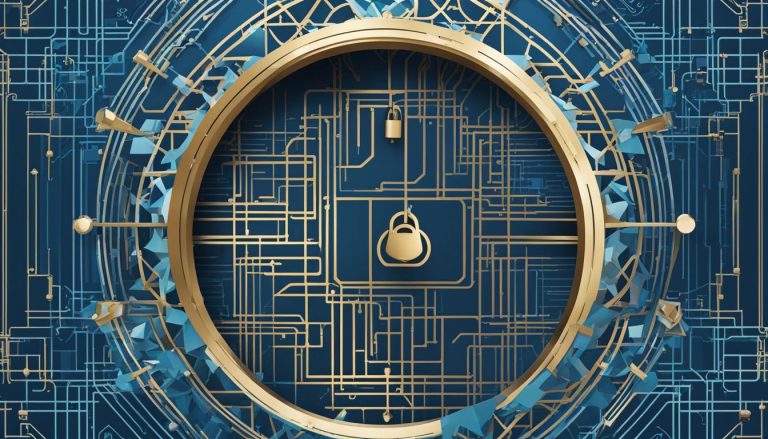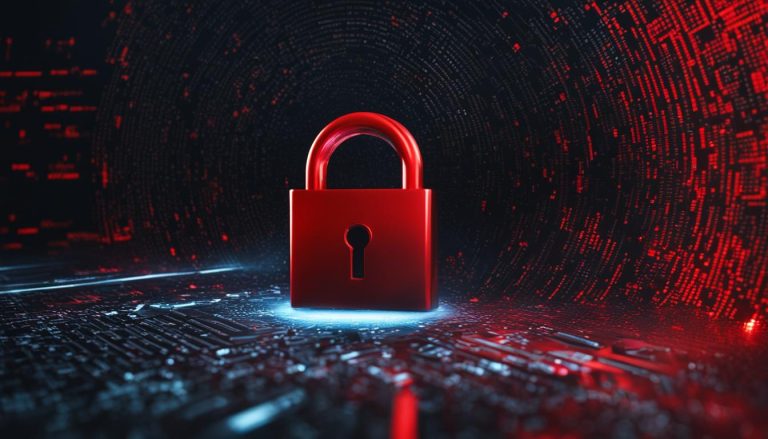Steganography, a technique shrouded in secrecy, holds the power to conceal sensitive information within seemingly innocent files. This ancient art has stood the test of time and transformed with technological advancements. From a ruler tattooing a hidden message on a slave’s head to hiding digital data within media files, steganography has evolved. Today, it plays a crucial role in data security, challenging investigators to uncover hidden secrets.
Key Takeaways:
- Steganography is the art of hiding information within harmless files.
- It has been used for centuries and has evolved with technology.
- Techniques like LSB steganography modify the least significant bits of a media file.
- Steganography finds applications in secure communication and data protection.
- Ethical usage and responsible practices are essential in the world of steganography.
The Techniques of Steganography
In steganography, various techniques are employed to effectively conceal information, making it difficult to detect. One popular technique is LSB steganography, where data is hidden by altering the least significant bits of a media file. This technique takes advantage of the fact that altering the least significant bits of a pixel doesn’t significantly impact the overall image quality. Another technique involves word or letter substitution, where the secret message is distributed within a larger text by placing the words at specific intervals. This technique relies on the fact that small changes in text formatting or word choice are unlikely to be noticed by casual observers.
There are also more advanced methods like palette-based image steganography, which focuses on modifying the color palette of an image to hide the secret data. Discrete cosine transform (DCT) is another technique commonly used in steganography, where data is embedded in the high-frequency coefficients of the transform. Bit-plane complexity segmentation (BPCS) technique involves dividing an image into bit-planes and allocating data to each bit-plane based on complexity. Additionally, wideband techniques using pseudorandom sequences or frequency hopping can be employed to hide data within audio or radio signals. Each technique has its own advantages and limitations, but they all serve the purpose of hiding data in a way that goes unnoticed.
| Technique | Description |
|---|---|
| LSB steganography | Data is hidden by altering the least significant bits of a media file. |
| Word or Letter Substitution | The secret message is distributed within a larger text by placing words at specific intervals. |
| Palette-based Image Steganography | Modifies the color palette of an image to hide the secret data. |
| Discrete Cosine Transform (DCT) | Data is embedded in the high-frequency coefficients of the transform. |
| Bit-Plane Complexity Segmentation (BPCS) | An image is divided into bit-planes and data is allocated based on complexity. |
| Wideband Techniques | Pseudorandom sequences or frequency hopping are used to hide data within audio or radio signals. |
Steganography techniques are constantly evolving, as researchers and security professionals work to stay ahead of potential threats. The advancements in technology provide new opportunities for malicious actors to exploit steganography, making it crucial to constantly innovate and develop new detection techniques. Through ongoing research and development, we can ensure that the techniques of steganography remain both a valuable tool for covert communication and a subject of exploration for security experts.
Applications of Steganography
Steganography finds applications in various scenarios where secure communication and data protection are crucial. It is commonly used for covert communication, allowing individuals to exchange sensitive information discreetly. By hiding data within innocuous files such as images, videos, or audio, steganography enables the transfer of confidential messages without raising suspicion.
Steganography is also employed in document protection. Critical information can be concealed within whitespace characters, preventing unauthorized access or tampering. This technique ensures the integrity and confidentiality of sensitive documents, safeguarding them from unauthorized individuals.
Additionally, steganography is used in digital watermarking. Invisible marks are embedded in images or documents to protect intellectual property and verify authenticity. This helps to prevent plagiarism and detect unauthorized use of copyrighted material.
| Applications of Steganography | Description |
|---|---|
| Covert Communication | Allows discreet exchange of sensitive information |
| Document Protection | Conceals critical information within whitespace characters to prevent unauthorized access or tampering |
| Digital Watermarking | Embeds invisible marks in images or documents for intellectual property protection and authenticity verification |
These are just a few examples of how steganography can be applied in different domains to ensure secure communication and data privacy. The versatility and effectiveness of steganography make it a valuable tool for concealing information and protecting sensitive data.
Tools for Steganography
When it comes to implementing steganography, a range of tools is available to help conceal information within digital files. These tools are designed to make the process easier and more accessible for users, whether for educational purposes or potentially malicious activities. Let’s explore some of the popular steganography tools that are widely used today.
Open-Source Tools
Open-source steganography tools provide users with free and accessible options for encoding and decoding hidden messages within various types of files. Some popular open-source tools include:
- Snow: This tool allows users to hide messages within whitespace characters, making it a versatile option for concealing information.
- Steghide: Steghide is a command-line tool that supports hiding information within images and audio files using robust encryption algorithms.
- OpenStego: OpenStego offers features for embedding secret messages within image files, providing users with a user-friendly interface for steganography.
- Whitespace: Whitespace is a tool specifically designed for hiding information within whitespace characters, allowing for covert communication.
Closed-Source/Commercial Tools
For users seeking more advanced features and additional security, closed-source or commercial steganography tools are available. These tools provide greater functionality and sophisticated capabilities to meet the needs of users requiring enhanced steganography functionalities. Some popular closed-source/commercial tools include:
- SilentEye: SilentEye offers a range of advanced steganography features, including support for multiple file formats and encryption algorithms.
- OutGuess: OutGuess is a popular steganography tool known for its ability to hide information within images while preserving the visual quality of the image.
- Masker: Masker is a comprehensive steganography tool that supports various file formats and offers advanced features like data compression and encryption.
| Open-Source Tools | Closed-Source/Commercial Tools |
|---|---|
| Snow | SilentEye |
| Steghide | OutGuess |
| OpenStego | Masker |
| Whitespace |
These tools allow users to leverage steganography techniques for various purposes, providing a wide range of options to suit different needs. It is important to note that the responsible and ethical use of steganography tools is crucial to ensure data privacy and security.
Steganalysis: Detecting Steganography
Steganalysis is a crucial field that focuses on the detection and analysis of hidden messages within digital content. While steganography aims to conceal information, specialized techniques and tools have been developed to identify potential instances of concealment. The ability to detect steganography plays a vital role in uncovering covert communication and ensuring responsible use.
Various tools, such as StegExpose and StegAlyze, have been created to detect the presence of hidden data in files. These tools analyze the file structure and look for patterns or anomalies that indicate the presence of concealed information. However, steganography techniques continue to evolve, making detection a challenging task.
Continued research and development in steganalysis are necessary to stay ahead of threat actors who employ steganography for malicious purposes. Security professionals and researchers must continuously update their knowledge and techniques to effectively counteract potential threats. By staying informed about emerging trends and advancements in steganography, we can better protect sensitive information and ensure secure communication in the digital age.
The Role of Steganalysis
Steganalysis plays a critical role in maintaining data security by actively searching for hidden messages within digital files. Its purpose is to identify potential misuse and prevent the malicious use of steganography. By analyzing files for signs of data concealment, steganalysis helps uncover covert communication channels and protect against threats.
The Challenges of Steganography Detection
The detection of steganography poses several challenges due to the evolving nature of concealment techniques. As new methods and algorithms are developed, steganalysis techniques must keep pace to effectively identify hidden messages. Furthermore, the increasing use of sophisticated encryption and advanced steganography tools makes it even more challenging to detect concealed information.
Researchers and security professionals constantly strive to develop new steganalysis methods to improve detection accuracy. By understanding the complexities of steganography and continuously advancing detection techniques, we can stay one step ahead of those who seek to exploit this technique for malicious purposes.
Ethical Considerations and Responsible Use of Steganography
As steganography becomes more prevalent in various domains, it is essential to address the ethical considerations and responsible use of this technique. Ethical usage involves adhering to legal regulations and privacy laws governing data security and communication. Respecting boundaries and obtaining proper consent are crucial aspects of using steganography responsibly. While cryptography alone may raise suspicion in highly monitored environments, steganography provides a valuable tool for covert communication. However, individuals and organizations must be aware of the potential risks and consequences associated with its misuse.
Responsible use of steganography also entails acknowledging the potential impact on trust and relationships. Transparent communication is the foundation of trust, and the use of steganography should not undermine open and honest interactions. It is vital to weigh the need for secrecy against the potential harm caused by concealing information. Striking a balance between privacy and openness is crucial to maintaining ethical practices in steganography.
Moreover, respecting the privacy and consent of individuals is of utmost importance. Using steganography without appropriate authorization is a violation of privacy rights and can have severe consequences. It is essential to obtain consent from all parties involved before employing steganography to ensure ethical usage.
Lastly, responsible use of steganography involves continuous education and awareness. Understanding the legal and ethical boundaries of this technique is crucial to avoid unintentional misuse and potential harm. Staying informed about the latest advancements in steganalysis and countermeasures is necessary to detect and prevent malicious activities. Upholding ethical standards in steganography promotes responsible use and contributes to a safer digital environment.
Key Considerations for Ethical Usage of Steganography
- Adhere to legal regulations and privacy laws governing data security and communication.
- Obtain proper consent and respect the privacy of individuals involved.
- Weigh the need for secrecy against the potential harm caused by concealing information.
- Strive for a balance between privacy and openness in communication.
- Stay informed about the latest advancements in steganalysis to detect and prevent potential misuse.
“With great power comes great responsibility.” – Uncle Ben
By embracing ethical considerations and responsible use, steganography can continue to be a valuable tool for secure communication while maintaining trust and privacy. It is up to individuals and organizations to wield this power responsibly, ensuring that the benefits of steganography are realized without compromising ethical standards.
The Future of Steganography
As technology continues to advance, the future of steganography holds immense potential for further innovations in secure communication and data privacy. Hackers and security professionals alike are constantly exploring new ways to leverage steganography for their respective purposes. With emerging technologies like augmented reality (AR) and virtual reality (VR) gaining traction, there may be new opportunities for malicious actors to exploit steganography in these mediums.
Additionally, as communication methods evolve and encryption techniques become more sophisticated, creative hackers will continue to find ways to bypass protections and use steganography for their malicious activities. The seamless integration of hidden information within innocuous files enables covert communication, making it difficult to detect and prevent. Therefore, security professionals and researchers must stay informed about emerging trends and advancements in steganography to effectively counteract potential threats.
However, it is not only hackers who are innovating in the field of steganography. Security organizations and researchers are continually developing new detection techniques and tools, advancing the field of steganalysis. With ongoing research in steganalysis, security experts can detect and analyze hidden messages within digital content, helping to identify and prevent potential misuse of steganography.
Steganalysis plays a vital role in identifying potential misuse and ensuring responsible use of steganography.
While steganography offers numerous benefits for secure communication and data protection, it is essential to emphasize ethical considerations and responsible usage. Adhering to legal regulations and privacy laws governing data security and communication is paramount. Individuals and organizations must be aware of the potential risks and consequences associated with the misuse of steganography.
By understanding the techniques, applications, and tools associated with steganography, individuals and organizations can navigate this field responsibly and contribute to the development of secure communication practices. As technology evolves, steganography will continue to play a significant role in ensuring data privacy, and ongoing research in steganalysis will be crucial to detect and prevent its misuse.
Innovations in Steganography
The future of steganography will witness an array of innovations as security professionals develop new techniques and tools to counteract evolving threats. Some key areas of innovation include:
- Advanced steganography algorithms: Researchers will continue to enhance existing steganography algorithms or develop new ones to ensure the secure hiding of information within files.
- Integration with emerging technologies: With the rise of technologies like blockchain and quantum computing, there may be opportunities to integrate steganography with these technologies to enhance data security and privacy.
- Dynamic steganography: Future advancements may focus on creating dynamic steganography methods that adapt to changing communication patterns and effectively evade detection.
- Steganography in multimedia: As multimedia content becomes more prevalent, there will be a need for innovative steganography techniques specific to images, videos, and audio files.
The future holds exciting possibilities for steganography, both in terms of secure communication and the efforts to counteract its misuse. Continued research and development in steganography and steganalysis will play a vital role in staying ahead of emerging threats and ensuring the responsible use of this powerful technique.
Conclusion
Steganography is a fascinating field that allows for the covert communication and protection of sensitive information. The techniques employed in steganography, such as LSB steganography, word substitution, and image manipulation, make it difficult to detect hidden data. Various applications of steganography, including covert communication, document protection, and digital watermarking, demonstrate its significance in ensuring secure communication and data privacy.
To facilitate the implementation of steganography, a wide range of tools, both open-source and commercial, are available. These tools provide users with the ability to encode and decode hidden messages, offer encryption algorithms, and integrate with other security technologies. However, it is important to note that detection techniques and tools for steganalysis are continuously evolving to identify potential instances of steganography.
Responsible use of steganography is crucial to maintain ethical boundaries and adhere to legal regulations. It is important to understand the implications and consequences associated with the misuse of steganography. As technology continues to advance, further innovations in steganography are expected, presenting both opportunities and challenges for secure communication and data privacy. Ongoing research and development in steganalysis are necessary to stay ahead of potential threats and ensure responsible use of steganography.
FAQ
What is steganography?
Steganography is a technique that allows the hiding of sensitive information within innocuous files, such as images, videos, and audio.
How does steganography work?
Steganography works by concealing data in a way that doesn’t arouse suspicion, making it difficult to detect. Techniques like LSB steganography modify the least significant bits of a media file to hide information.
Can steganography be used for malicious purposes?
Yes, steganography can be used for both benign and malicious purposes. It is important to use steganography responsibly and adhere to legal regulations and privacy laws.
What are some applications of steganography?
Steganography finds applications in various scenarios where secure communication and data protection are crucial. It can be used for covert communication, document protection, and digital watermarking, among other purposes.
Are there tools available for implementing steganography?
Yes, numerous tools are available that facilitate the implementation of steganography. Open-source tools like Snow, Steghide, OpenStego, and Whitespace provide features for encoding and decoding hidden messages within whitespace characters. Closed-source or commercial tools like SilentEye, OutGuess, and Masker offer advanced capabilities and additional security features.
How can steganography be detected?
Specialized techniques and tools have been developed for steganalysis, which refers to the detection and analysis of hidden messages within digital content. Tools like StegExpose and StegAlyze can detect the presence of hidden data in files, although steganography techniques continue to evolve, making detection challenging.
What are the ethical considerations of using steganography?
Ethical usage and disclosure are crucial when it comes to steganography. It is important to adhere to legal regulations and privacy laws governing data security and communication. Steganography should be used responsibly for educational purposes only, emphasizing the importance of obtaining proper consent and ensuring ethical practices.
What does the future hold for steganography?
As technology continues to advance, the future of steganography holds the potential for further innovations in secure communication and data privacy. With the rise of new mediums like augmented reality (AR) and virtual reality (VR), there may be new opportunities for malicious actors to exploit steganography. Ongoing research and development in steganalysis will be crucial to detect and prevent misuse.
Cathy is a senior blogger and editor in chief at text-center.com.


